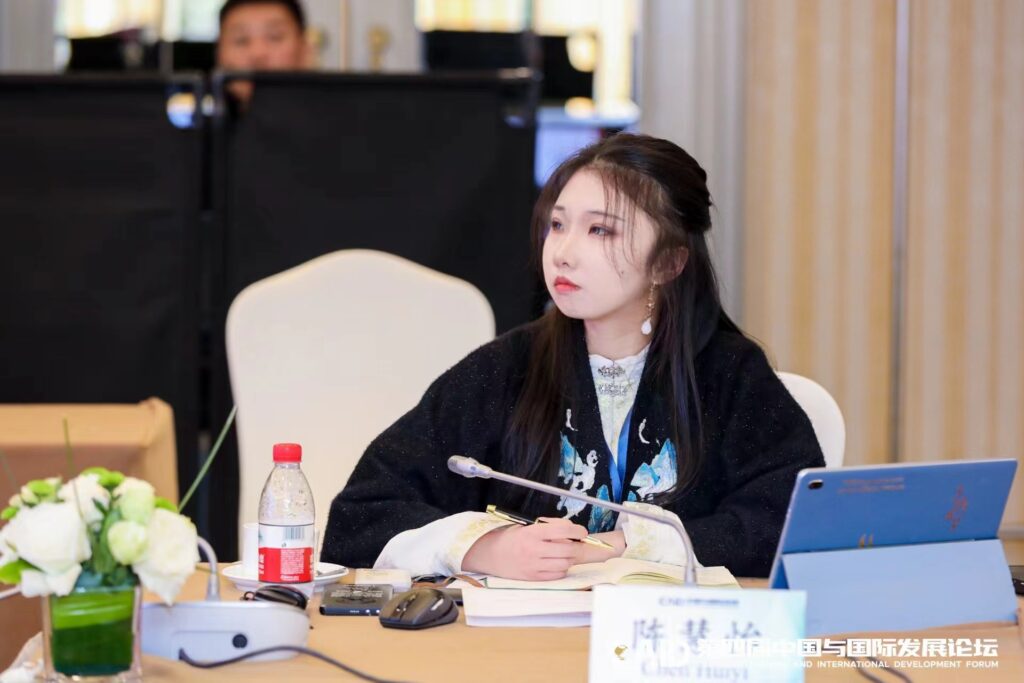Date Published: December 18, 2023.
Speech delivered by Development Reimagined Analyst Huiyi Chen during a thematic session hosted by the Chinese Academy of International Trade and Economic Cooperation (CAITEC) in Beijing in December 2023.
FULL SPEECH BELOW
Thank you very much Vice President Yu Zirong, distinguished guests, and colleagues in the international development community, good morning!
Firstly, I would like to extend our heartfelt gratitude to the Chinese Academy of International Trade and Economic Cooperation (CAITEC) for extending this gracious invitation to Development Reimagined to join this thematic session.
For Development Reimagined, as an African-led, independent international development consultancy, working on cutting-edge development issues, especially in China-Africa cooperation, it is great to see that as a major creditor in Africa, attention has been raised from China to look at different options in debt reorganisation, including debt-for-development swaps that we are discussing today and I would like to share an African perspective on exploring the potential of this instrument.
Throughout the COVID-19 pandemic to the present, there has been an abundance of headlines about how the ability of African countries to service debts has been undermined and that there is a mounting debt crisis in Africa. Such narratives leave the false impression that African countries have been spending loans badly and neglected their imperative to access financing to fill their infrastructure and other spending gaps. We’ve also seen the limited effectiveness of previous instruments, for example, the G20’s Debt Service Suspension Initiative (DSSI) and then the Common Framework, as already mentioned by Mr Zhou Xuwen.
Our research on development finance has argued that the International Finance System (IFS) needs to be reimagined and redesigned to centre borrowers, providing significantly more fair and concessional finance, especially for low-income countries to fund their growth and achieve the UN Sustainable Development Goals (SDGs).
Also, to put it simply – for African countries, fast, unconditional debt relief alongside fast access to new concessional finance is what they are in dire need of when seeking debt relief. Therefore, when we are making new proposals to innovate the debt system, if we are not just thinking about how easy or plausible it is for creditors and really taking the borrowers and their long-term development into account, these proposals need to be assessed against these criteria.
Under such context, the question of what makes debt-for-development swaps a good alternative for China and its African debtors – is clear.
The African debtors may be able to access more flexible financial arrangements with China and can negotiate on the concessional terms, the design of specific development programs, and possibly the use of other supplemental financing instruments. We know that under the presence of constant and sometimes uncertain obligations to make debt repayments, these African governments were prevented from further investing in critical sectors like climate, health and education, the debt swap targeted at these sectors resolved their budget shortfalls. It represents a positive sign of moving away from the traps in the existing deadlocks with debt restructuring and a driving force to continue the progress with SDG commitments that are otherwise often underfunded.
For China, an option aligns with the commitment to support Africa on the governance of debt and other issues such as climate, health, and education, for which the debt-for-development swaps are best known and also included in the Forum on China-Africa Cooperation (FOCAC) Dakar Action Plan. It helps refute the speculative criticisms around the “debt trap” narrative.
In addition, members of the Paris Club are only allowed to consent to debt swaps if the “IMF positively assesses that the debtor country’s debt restructuring program helps stabilize international trade relations,” and this rule has made it difficult for the Paris Club countries to engage in debt swaps with their borrowers. As a non-Paris Club major lender, China and African borrowers would not be constrained by such rules and could take the initiative in formulating creative solutions. By taking it to the next level, China and Africa together can have the capacity to leverage more international finance institutions to follow the lead.
Despite these benefits, there are also several drawbacks that we need to be aware of:
As the presentation by Ms Sun Tianshu already raised – The amount subjected to debt-for-development swaps is often too small to reduce the debt burden or improve the creditworthiness. For example, a 2021 debt-for-nature swap in Belize offered it debt relief worth 12 per cent of its GDP, but this was only a small dent in the 125 per cent that its total debt amounted to at the time. The lack of large-scale debt-for-development swaps also makes the ability to have a sustained impact on the recipient questionable.
Another fundamental disadvantage of debt swaps is that the additional fiscal space created from debt relief will usually materialize within an extended period of time (ranging from several years to even decades). On the contrary, debt service payments can be due much earlier. Put differently, in many instances, there is not enough time for a borrower to increase its fiscal spending in core sectors (such as education and health) since its ongoing debt service commitments may result in a myopic (or shortsighted) treatment of the additional fiscal space created. This comes to the issue of how to maintain a balance between repaying debts and investing in sustainable development projects.
Furthermore, the issue of fungibility on behalf of the debtors often leads creditor countries to exercise strict control over how funds from debt swaps are allocated and used by the recipient country. Previous practices, especially those led by Global North countries, tend to be further complicated with the conditionalities in terms of how funds generated from the debt swaps should be spent.
Lastly, as we are all aware of, and why we are making this pioneering discussion here today, the limited application and lack of experience add to the administrative costs compared to simple debt cancellation, and additional challenges in project selection and implementation, as well as robust monitoring mechanisms to ensure the accountability and transparency.
The debt-for-development swap, as an option, awaits further policy guidance and implementation. There is certainly a great deal of work to do and hereby, we make several recommendations for China and the African partners to explore the potential:
Firstly, even if the amount is relatively small, they are still meaningful financing if it can be strategically channeled into programs that are designed to generate long-term productivity and address issues of economic vulnerability. I would also like to point out that while at the current stage, debt-for-development swaps are best known for their application in sectors like environment, health, and education, the scope could also be expanded, for instance, into agriculture. Just to give a quick example – the 3rd phase of the $100 million debt swap program between Egypt and Italy includes include the establishment of Field Silos and Information Technology System for a Wheat Management project.
When it comes to sovereignty concerns as well as the on-ground implementation, several African institutions can serve as ideal third parties for China and African borrowers to manage and advise on the effective use of debt swaps, providing expertise, oversight, and guidance to ensure that the swaps align with the developmental goals of the participating countries. These partners include the African Development Bank (AfDB), the UN Economic Commission for Africa (UNECA), the African Institute for Economic Development and Planning (IDEP) and regional economic communities. It is also critical for African countries to exercise agency and be the promoters themselves to propose development programs suitable for debt swaps and with specific guidelines provided to the Chinese counterparts.
A common practice is for the debtor to transfer the equivalent in local currency of debt cancelled to an established international trust fund, such as to support the projects in the debtor country. There are previous cases of sector-targeted funds between AfDB and other partners, like the Health in Africa Fund, and Africa Climate Change Fund; which is also why I raised the role African DF institutions can play. Back in 2014, the PBoC and AfDB established the co-financed Africa Growing Together Fund to sponsor projects over the next ten years. We recommend the replenishment of that fund is worth considering if we are looking for channels to utilize the debt-for-development swaps, especially since there is already a certain level of inter-ministerial coordination in place to facilitate the process.
Considered from a borrowers’ perspective, since debt swaps have been typically negotiated on a bilateral basis, and individual borrowers do not possess significant bargaining power. There is the opportunity to consider multilateral debt swaps for a targeted development sector that is a shared priority by several countries. Arguably more complex negotiations and transaction costs at the beginning, but in the long-term a multilateral mechanism mitigates the risks for the creditor and contributes to consistency and better coordination, as well as additional fund sources to support cross-border and regional projects.
I would also like to mention that since debt cancellation applies only to countries in severe debt crises, and the amount of debt-for-development swaps is small, China could consider extending the eligibility of debt swaps to include borrowers experiencing less severe debt stress, in exchange for commitments such as in nature-positive investment, which aligned with the FOCAC commitments to step up support in those sectors – Egypt could be a good case.
In response to the question of is debt-for-development swaps a silver bullet? We are aware that it does not address the root causes of debt distress, and we need to bear in mind that it’s a stand-alone approach; more systematic reform is needed in the debt system, as well as supplement with other instruments in the policy, such as a rethinking of the debt sustainability assessment facilitating the reallocation of Special Drawing Rights (SDRs).
With all that being said, when the incentives to promote and the mechanism to implement are well-understood and well-designed, the debt-for-development swaps are a valuable and viable instrument that with suggested modifications come from diverse stakeholders based on previous experiences, can simultaneously contribute to the relief of debt distress, while supporting the long-term social and economic development in Africa.
As for China, by embracing this new solution, can demonstrate commitment and leadership in addressing the interlinked challenges of debt and the lack of progress in achieving SDGs, thereby contributing to a more resilient post-pandemic recovery for Africa and for the Global South a220s a whole.
For Development Reimagined, we are looking forward to supporting with an understanding of the debt situation in Africa and facilitating the negotiations and designing of governance architecture for debt-for-development swap as a new instrument.
Thank you very much!


December 2023


